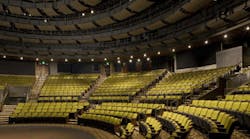Since opening its doors in 1967, the Mark Taper Forum — better known as the Taper — has not only become a Los Angeles landmark, but is also one of America's leading resident theaters. Like an aging Hollywood actor, however, the 41-year-old structure found itself in need of cosmetic surgery. Thanks to a recent $30-million overhaul, the 30,000-square-foot building has been brought into the 21st century and is once again taking center stage in the City of Angels.
“The theater was very antiquated,” says Terry Bottorff, senior project manager for Cypress, Calif.-based Taisei Construction Corp., the project's general contractor. “It hadn't been renovated since a small refurbishment done in the late 1980s. With the exception of the structural walls, we gutted the entire inside.”
According to Bottorff, electrical installations in theaters typically prove difficult, but the design of the Taper made this restoration's challenges even more pronounced. Part of the Music Center of Los Angeles, the structure is a circular design by architect Welton Becket. In addition, the theater features a unique thrust stage that extends into the audience on three sides and is connected to the backstage area by its upstage end.
“Keep in mind this building is round, which means it has six different radius points,” notes Bottorff. “Subcontractors were hired to install the lighting control and audio systems, which was no small task. In the Taper's overhead catwalks alone, approximately 240,000 linear feet of conduit was laid. That's a little over 45 miles.”
Because the facility's various systems — including electrical, audio, sprinkler, and HVAC — follow along the catwalks on racks, the electrical contractor, Santa Fe Springs, Calif.-based CSI Electric, used 3D modeling prior to installation to ensure no obstructions or interference occurred during the installation.
“The systems had to be layered, so CSI Electric color-coded each of them to eliminate potential confusion,” explains Bottorff. “To avoid crosstalk on the audio system cables, the systems had to be separated by certain distances. This proved extremely difficult.”
Another obstacle to be overcome involved the building's emergency generator that provides backup power to not only the Taper, but to the neighboring Ahmanson Theater as well.
“We had to upsize the generator, which is located seven floors underground in a parking structure that has very little headroom,” says Bottorff. “So first we put the generator together and ran the load bank tests on it. Then, we tore it apart, took it down to the underground room in pieces, and put it back together.”
To render the 740-seat theater more energy-efficient, compact fluorescent lamps (CFLs) were used when feasible. Furthermore, lights can be operated by one person via eight computer-controlled dimmer racks that allow numerous lighting scenes to be set, depending upon the desired mood.
Despite an unanticipated and large amount of asbestos abatement that had to be performed during hours when unprotected workers weren't present, the year-long project finished on time and under budget. “I was lucky enough to see the first production in the Taper after it reopened,” says Bottorff. “This is one of those projects that, when completed, you look back and you are really proud of it.”



